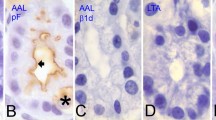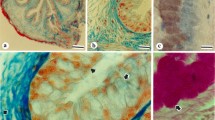Summary
Cationic colloidal gold (CCG) was used to characterize acidic glycoconjugates in semithin and ultrathin sections of rat large intestine and salivary glands embedded in hydrophilic Lowicryl K4M resin. It was prepared from poly-l-lysine and 10 nm colloidal gold solution. The staining of CCG in semithin sections was amplified after photochemical silver reaction using silver acetate as a silver ion donor and examined under bright-field and epi-illumination microscopy. CCG adjusted to various pH levels was tested on various rat tissues whose histochemical characteristics with regard to acidic glycoconjugates are well known. At pH 2.5 CCG labelled tissues containing sialylated and sulphated acidic glycoconjugates such as the apical cell surface, mucous cells in the distal and proximal colon, and acinar cells of the sublingual gland. In contrast, CCG at pH 1.0 labelled tissues containing sulphated acidic glycoconjugates such as mucous cells in the upper crypt of the proximal colon and mucous cells in the whole crypt of the distal colon. This specificity of CCG was verified by the alteration of CCG staining following several types of cytochemical pretreatment. These results were further confirmed by electron microscopy. CCG staining is thus a useful postembedding procedure for the characterization of acidic glycoconjugates at both the light- and electron-microscopic levels.
Similar content being viewed by others
References
BENNETT, G. & HEMMING, R. (1986) Presence of glycoproteins in the cell nucleus as shown by radioautographic studies after administration of [3H] fucose and [3H] galactose.Eur. J. Cell Biol. 42, 246–53.
CURRAN, R. C., CLARK, A. E. & LOVELL, D. (1965) Acid mucopolysaccharides in electron microscopy—the use of the colloidal iron method.J. Anat. 99, 427–34.
DANON, D., GOLDSTEIN, L., MARIKOVSKY, Y. & SKUTELSKY, E. (1972) Use of cationized ferritin as a label of negative charges on cell surfaces.J. Ultrastruc. Res. 38, 500–12.
ENOMOTO, S. & SCOTT, B. L. (1970) Intracellular distribution of mucosubstances in the major sublingual gland of the rat.Anat. Rec. 169, 71–95.
GUSTAFSON, G. T. & Pihl, E. (1967) Staining of mast cell acid glycosaminoglycans in ultrathin sections by ruthenium red.Nature 216, 697–8.
HACKER, G. W., GRIMELIUS, L., DANSCHER, G., BERNATZKY, G., Muss, W., Adam, H. & Thurner, J. (1988) Silver acetate autometallography: an alternative enhancement technique for immunogold-silver staining (IGSS) and silver amplification of gold, silver, mercury, and zinc in tissues.J. Histotechnol. 11, 213–21.
HALE, C. W. (1946) Histochemical demonstration of acid polysaccharides in animal tissues.Nature 157, 802.
HORISBERGER, M. & CLERC, M.-F. (1988) Chitosan-colloidal gold complexes as polycationic probes for the detection of anionic sites by transmission and scanning electron microscopy.Histochemistry 90, 165–75.
KAN, F. W. K. & PINTO DA SILVA, P. (1986) Preferential association of glycoproteins to the euchromatin regions of cross fractured nuclei is revealed by fracture-label.J. Cell Biol. 102, 576–86.
LONDONO, I. & BENDAYAN, M. (1987) Ultrastructural localization of mannoside residues on tissue sections: comparative evaluation of the enzyme gold and the lectin-gold approaches.Eur. J. Cell Biol. 45, 88–93.
LUFT, J. H. (1964) Electron microscopy of cell extraneous coats as revealed by ruthenium red staining.J. Cell Biol. 23, 54A-B.
MURATA, F., TSUYAMA, S., IHIDA, K., KASHIO, N., Kawano, M. & Zeng, Z. L. (1992) Cytochemical demonstration of sulfated glycoconjugates in epithelial cells and mesenchymal cells.J. Electron Microsc. 41, 14–20.
PALMER, T. F. & FILIPE, M. I. (1990) Non-immunohistochemical methods in tumor diagnosis. InHistochemistry in Pathology (Edited byFilipe, M. I. & Lake, B. D.) 2nd edn, pp. 61–97. Edinburgh, London, New York: Churchill Livingstone.
REID, P. E., OWEN, D. A., FLETCHER, K., ROMAN, R. E., REIMER, C. L., Rouse, G. J. & Park, C. M. (1989) The histochemical specificity of high iron diamine-alcian blue.Histochem. J. 21, 501–7.
REVEL, J.-P. (1964) A stain for the ultrastructural localizations of acid mucopolysaccharides.J. Microsc. 3, 535–44.
ROTH, J. (1983) Application of lectin-gold complexes for electron microscopic localization of glycoconjugates on thin sections.J. Histochem. Cytochem. 31, 987–99.
ROTH, J., Lucocq, J. M. & Charest, P. M. (1984) Light and electron microscopic demonstration of sialic acid residues with the lectin fromLimax flavus: a cytochemical affinity technique with the use of fetuin-gold complexes.J. Histochem. Cytochem. 32, 1167–76.
ROTH, J., TAATJES, D. J., LUCOCQ, J. M., WEINSTEIN, J. & PAULSON, J. C. (1985) Demonstration of an extensivetrans-tubular network continuous with the Golgi apparatus stack that may function in glycosylation.Cell 43, 287–95.
SANNES, P. L., SPICER, S. S. & KATSUYAMA, T. (1979) Ultrastructural localization of sulfated complex carbohydrates with a modified iron diamine procedure.J. Histochem. Cytochem. 27, 1108–11.
SKUTELSKY, E. & ROTH, J. (1986) Cationic colloidal gold — a new probe for the detection of anionic surface sites by electron microscopy.J. Histochem. Cytochem. 34, 693–6.
SKUTELSKY, E., GOYAL, V. & ALROY, J. (1987) The use of avidin-gold complex for light microscopic localization of lectin receptors.Histochemistry 86, 291–5.
SLOT, J. W. & GEUZE, H. J. (1985) A new method of preparing gold probes for multiple-labeling cytochemistry.Eur. J. Cell Biol. 38, 87–92.
SPICER, S. S. (1965) Diamine methods for differentiating mucosubstances histochemically.J. Histochem. Cytochem. 13, 211–34.
SPICER, S. S., Horn, R. G. & Leppi, T. J. (1967) Histochemistry of connective tissue mucopolysaccharides. InThe Connective Tissue (Edited byWargner, B. M. & Smith, D. E.) pp. 251–303. Baltimore: Williams & Wilkins.
SPICER, S. S., Hardin, J. H. & Setser, M. E. (1978) Ultrastructural visualization of sulphated complex carbohydrates in blood and epithelial cells with the high iron diamine procedures.Histochem. J. 10, 435–52.
STOWARD, P. J. (1990) Histochemical methods for routine diagnostic histopathology. InHistochemistry in Pathology (Edited byFilipe, M. I. & Lake, B. D.) 2nd edn, pp. 61–97. Edinburgh, London, New York: Churchill Livingstone.
TAKAGI, M., PARMLEY, R. T., SPICER, S. S., DENYS, F. R. & SETSER, M. E. (1982) Ultrastructural localization of acidic glycoconjugates with the low iron diamine method.J. Histochem. Cytochem. 30, 471–6.
Thiery, J.-P. & Ovtracht, L. (1979) Differential characterization of carboxyl and sulphate groups in thin sections for electron microscopy.Biol. Cell. 36, 281–8.
THOMOPOULOS, G. N., SCHULTE, B. A. & SPICER, S. S. (1983) Light and electron microscopic cytochemistry of glycoconjugates in the rectosigmoid colonic epithelium of the mouse and rat.Amer. J. Anat. 168, 239–56.
TICE, L. R. & BARRNETT, R. J. (1962) Alcian blue staining for electron microscopy.J. Histochem. Cytochem. 10, 688–9.
TSUYAMA, S., SUZUKI, S. & MURATA, F. (1983) The histochemical differences of intestinal gland epithelia in the rat colon with special reference to their glycoconjugates.Acta Histochem. Cytochem. 16, 456–71.
TSUYAMA, S., SUGANUMA, T., IHIDA, K. & MURATA, F. (1986) Ultracytochemistry of glycosylation sites of rat colonic mucous cells with labeled lectins.Acta Histochem. Cytochem. 19, 555–65.
VORBRODT, A. W. (1987) Demonstration of anionic sites on the luminal and abluminal fronts of endothelial cells with poly-l-lysine-gold complexes.J. Histochem. Cytochem. 35, 1261–6.
WETZEL, M. G., WETZEL, B. K. & SPICER, S. S. (1966) Ultrastructural localization of acid mucosubstances in the mouse colon with iron-containing stains.J. Cell Biol. 30, 299–351.
YOUNG, R. W. (1973) The role of the Golgi complex in sulfate metabolism.J. Cell Biol. 57, 175–89.
Author information
Authors and Affiliations
Rights and permissions
About this article
Cite this article
Kashio, N., Tsuyama, S., Ihida, K. et al. Cationic colloidal gold — a probe for light- and electron-microscopic characterization of acidic glycoconjugates using poly-l-lysine gold complex. Histochem J 24, 419–430 (1992). https://doi.org/10.1007/BF01089104
Received:
Revised:
Issue Date:
DOI: https://doi.org/10.1007/BF01089104




